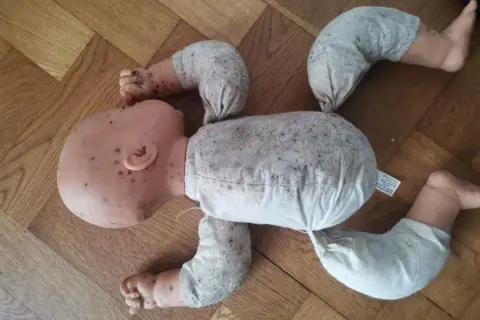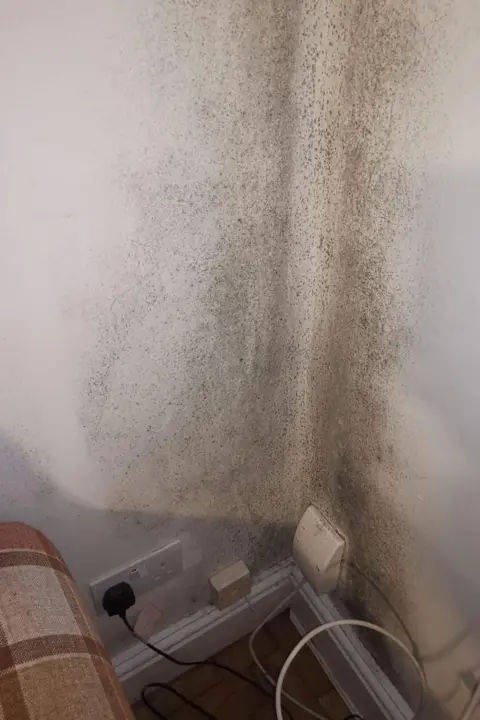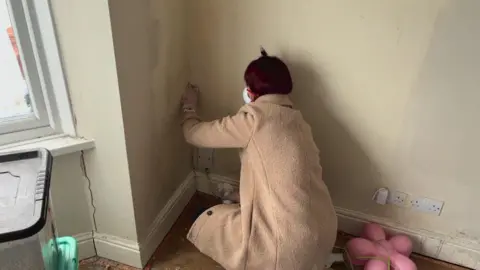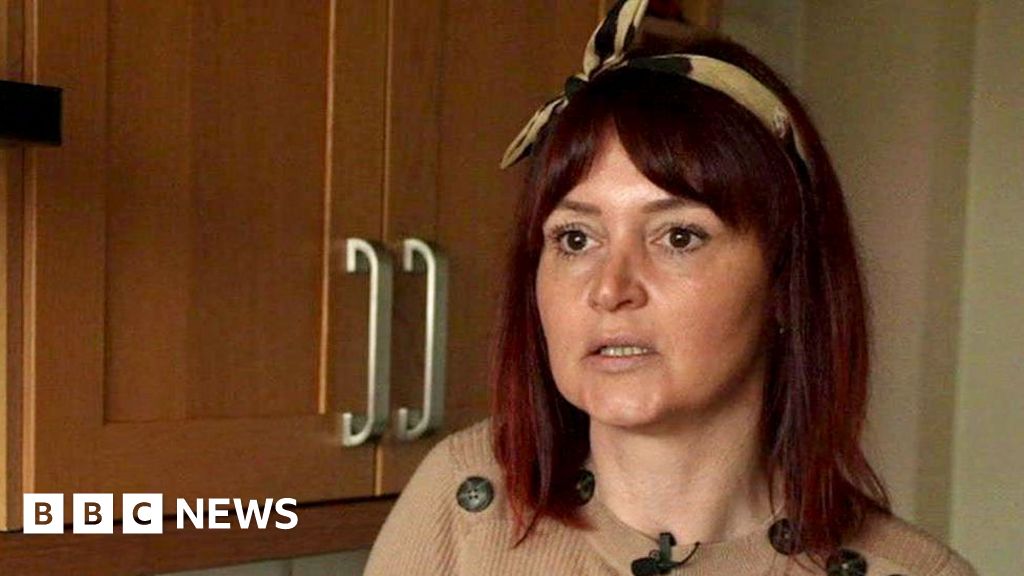Zoe Conway,BBC News correspondent
 BBC
BBCEvery two weeks Zoe Godrich scrapes the black mould off the walls of her children’s bedrooms.
She says her house now resembles a squat. ”It’s absolutely heartbreaking because I can’t provide for my children’s basic needs of a safe warm home.”
The mould took over after she had her Swansea home fitted with cavity-wall insulation three years ago. She says that within weeks, water was constantly running down the walls ”like a little waterfall”.
The BBC can reveal that cavity-wall insulation fitted under government-backed green energy schemes could have failed in hundreds of thousands of homes because it was not installed properly.
‘Botched’ installation
Single mum Zoe and her three children are now sleeping in one room, on mattresses on the floor. The other two bedrooms are uninhabitable, she says.
She says she has thrown all of their beds and wardrobes away because they were consumed by damp and mould. She shows me a photograph of her six-year-old daughter’s baby doll, covered in black mould, which she had to bin.
 Zoe Godrich
Zoe GodrichOne of her daughters takes several medications for asthma. Her son has eczema so severe, his cracked skin bleeds. She says they were not on these medications before the insulation was installed. The NHS says that damp and mould can lead to respiratory illnesses and skin conditions.
David Walter is a building surveyor who has been inspecting insulated homes all over the UK for more than 25 years. He visited Zoe’s home in April and said the installation had been “botched”, and the extraction hadn’t been done properly either.
He says there is nothing unusual about what has happened to Zoe’s home. ”The industry is motivated by money – they get government grants for doing this work. So there’s an incentive for the contractors just to get people signed up, get the job done and get the grant money.” He blames a lack of oversight and regulation for the problems.
Since 2008, more than three million homes have had cavity-wall insulation fitted under green energy schemes set up by the government. Energy suppliers were responsible for inspecting 5% of them to check for installation quality.
Figures compiled by energy watchdog Ofgem seen by the BBC suggest that insulation in hundreds of thousands of these homes could have failed because it was not installed properly.
In total 15 million homes have had their cavities filled.
Merry-go-round
 Zoe Godrich
Zoe GodrichA year after the problems began, Zoe went on a merry-go-round of companies and organisations to try to get help. She began in early 2022 with Installers UK, which carried out the installation work. The company insisted the insulation wasn’t to blame and then went bust.
The firm told the BBC the problems were caused by a hole in the roof, although it cannot provide a copy of the pre-installation report to confirm this. If there had been issues with the property, according to the standards body the British Assessment Bureau, they should have been fixed before the work was carried out.
Next, she contacted City Energy Network Limited, who secured the funding for Zoe’s home. Its name is on the guarantee for the work, although City Energy says this was an error and that it had nothing to do with the guarantee, which should have been issued by the company that did the work.
Zoe says she was advised to get the insulation removed. She took out a £7,000 loan to pay for it. What she didn’t know was that the extraction would invalidate the guarantee for the work. Without the insulation, the house is now very cold. She can’t afford to turn up the temperature, which is leading to yet more damp and mould.

City Energy told the BBC that its only involvement was to fund a grant through the government scheme. It says it has no connection with Installers UK, nor was it involved in the installation or removal process.
The government recognised that standards needed to be improved several years ago. It tasked the independent organisation Trustmark to set up an assurance quality scheme in 2019.
But the problems that Zoe has faced raises questions over how well the scheme is working. Both Installers UK, which carried out the work in 2021, and City Energy, which secured the grant money, were Trustmark-registered.
Zoe says she sees no resolution in sight. ”The life has just been sucked out of me. For the last few years all I’ve done is fight company after company after company.”
City Energy says although it has no obligation to provide any assistance, it has ”recognised and sympathised with the position in which Ms Godrich finds herself” and says it has sought to resolve matters directly with her in an effort to assist.
In a statement, Trustmark told the BBC: ”The problems at Ms Godrich’s property are complex. The work was carried out under an earlier standard and did not take the ‘whole house’ approach that current standards do, preventing some of the issues seen here.
“However, the situation Ms Godrich is left in is completely unacceptable and needs to be put right. We will work with the British Assessment Bureau and City Energy to achieve a suitable solution that makes Ms Godrich’s property a warm, comfortable and healthy home for her and her family.”
The Department for Energy Security and Net Zero declined to comment but referred us to a ministerial statement in February that said: “The Government is committed to protecting all consumers undertaking home retrofit work as well as improving the overall consumer journey.”


